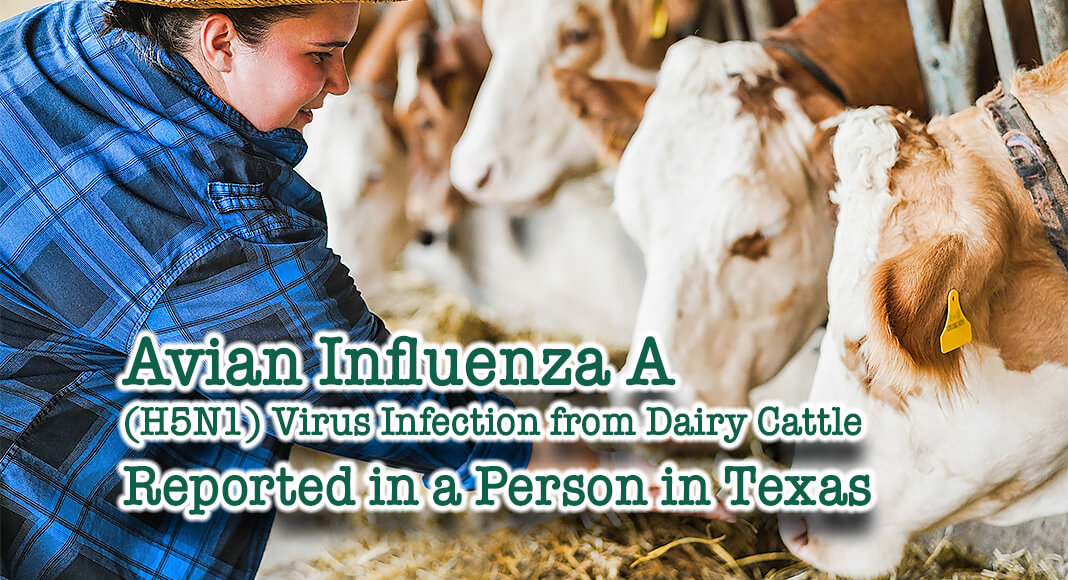
Mega Doctor News
A person in the United States has tested positive for highly pathogenic avian influenza (HPAI) A(H5N1) virus (“H5N1 bird flu”), as reported by Texas and confirmed by CDC. This person had exposure to dairy cattle in Texas presumed to be infected with HPAI A(H5N1) viruses. The patient reported eye redness (consistent with conjunctivitis), as their only symptom, and is recovering. The patient was told to isolate and is being treated with an antiviral drug for flu. This infection does not change the H5N1 bird flu human health risk assessment for the U.S. general public, which CDC considers to be low. However, people with close or prolonged, unprotected exposures to infected birds or other animals (including livestock), or to environments contaminated by infected birds or other animals, are at greater risk of infection. CDC has interim recommendations for prevention, monitoring, and public health investigations of HPAI A(H5N1) viruses.
CDC is working with state health departments to continue to monitor workers who may have been in contact with infected or potentially infected birds/animals and test those people who develop symptoms. CDC also has recommendations for clinicians on monitoring, testing, and antiviral treatment for patients with suspected or confirmed avian influenza A virus infections.
This is the second person reported to have tested positive for influenza A(H5N1) viruses in the United States. A previous human case occurred in 2022 in Colorado. Human infections with avian influenza A viruses, including A(H5N1) viruses, are uncommon but have occurred sporadically worldwide. CDC has been monitoring for illness among people exposed to H5 virus-infected birds since outbreaks were first detected in U.S. wild birds and poultry in late 2021. Human illnesses with H5N1 bird flu have ranged from mild (e.g., eye infection, upper respiratory symptoms) to severe illness (e.g., pneumonia) that have resulted in death in other countries.
H5 bird flu is widespread among wild birds in the U.S. and globally. These viruses also have caused outbreaks in commercial and backyard poultry flocks, and sporadic infections in mammals. HPAI in dairy cows was first reported in Texas and Kansas by the U.S. Department of Agriculture (USDA) on March 25, 2024. Unpasteurized milk from sick cattle collected from two dairy farms in Kansas and one in Texas, as well as a throat swab from a cow in another dairy in Texas, tested positive for HPAI A(H5) viruses of the genetic clade 2.3.4.4b, which is the same clade that is widespread among birds globally. On March 29, 2024, USDA’s National Veterinary Services Laboratories (NVSL) confirmed HPAI in a Michigan dairy herd that had recently received cows from Texas. The USDA Animal and Plant Health Inspection Service (APHIS) is providing regular updates on detections in dairy herds, as well as information on epidemiological findings and biosecurity guidance for farmers and veterinarians. Preliminary analysis of A(H5N1) viruses has not found changes that would make these viruses resistant to current FDA-approved flu antiviral medications, so these are believed to be effective against these viruses. Candidate vaccine viruses (CVVs) developed against related clade 2.3.4.4b viruses are available for vaccine manufacturing if necessary and preliminary analysis indicates that they may provide reasonable protection against H5N1 influenza viruses. Seasonal flu vaccines do not provide protection against these viruses. Analysis of virus samples is ongoing.
CDC is working closely with state and federal agencies, including USDA, the Food and Drug Administration (FDA), and local health authorities to further investigate and closely monitor this situation.
Prevention Measures
According to CDC’s interim recommendations, people should avoid unprotected exposures to sick or dead animals including wild birds, poultry, other domesticated birds, and other wild or domesticated animals (including cattle), as well as with animal carcasses, raw milk, feces (poop), litter, or materials contaminated by birds or other animals with confirmed or suspected HPAI A(H5N1)-virus infection. People should not prepare or eat uncooked or undercooked food or related uncooked food products, such as unpasteurized (raw) milk, or products made from raw milk such as cheeses, from animals with confirmed or suspected HPAI A(H5N1)-virus infection (avian influenza or bird flu). Specific recommendations for farmers; poultry, backyard flock, and livestock owners; and worker protection are also available.
People exposed to birds or other animals with confirmed or suspected HPAI A(H5N1) virus infection should be monitored for any signs and symptoms of illness for 10 days after the last known exposure, including people wearing recommended personal protective equipment (PPE). Additional information on protective actions around birds, including what to do if you find a dead bird, is available on CDC’s website.
According to FDA and USDA, there are not concerns with the safety of the commercial milk supply at this time because products are pasteurized before entering the market. Dairies are required to send only milk from healthy animals into processing for human consumption; milk from impacted animals is being diverted or destroyed so that it does not enter the human food supply. In addition, pasteurization has continually proven to inactivate bacteria and viruses, like influenza, in milk. Pasteurization is required for any milk entering interstate commerce for human consumption. FDA’s longstanding position is that unpasteurized, raw milk can harbor dangerous microorganisms that can pose serious health risks to consumers, and FDA is reminding consumers of the risks associated with raw milk consumption in light of the HPAI detections.
CDC continues to work with USDA, FDA, and state health departments to monitor people exposed to animals infected with HPAI A(H5N1) viruses. Because influenza viruses constantly change, continued surveillance and preparedness efforts are critical, and CDC is taking measures in case the public health risk assessment changes. This is a developing situation, and CDC will share additional updates as new relevant information becomes available.











